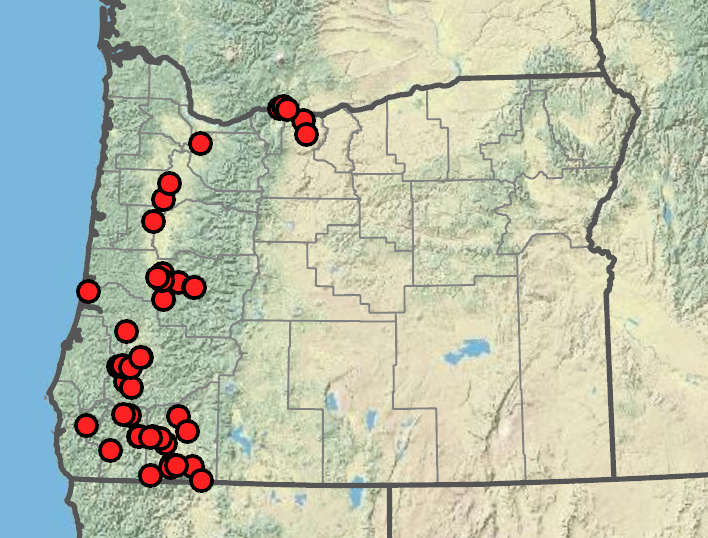Trifolium ciliolatum
Trifolium incarnatum
foothill clover
crimson clover
palmate;
leaflets 3, elliptic to oblong or obovate, 8–35 × 5–15 mm, bases cuneate;
margins serrate proximally, obscurely denticulate distally;
veins thickened;
tips usually rounded or retuse, rarely acute;
surfaces glabrous;
petioles 10–130 mm;
petiolules ~0.5 mm;
stipules ovate-lanceolate, 10–15 mm;
margins entire, sometimes ciliate;
tips acuminate.
pinnate;
leaflets 3, broadly ovate, 10–30 × 10–15 mm, bases cuneate;
margins denticulate;
veins fine;
tips emarginate or retuse;
surfaces with spreading pustule-based hairs;
petioles 10–80 mm;
petiolules 1 mm;
stipules ovate, 10–20 mm;
margins wavy or toothed;
tips blunt or somewhat tapering distally.
axillary or terminal, 10–30-flowered; ovoid becoming subglobose, 7–22 × 5–20 mm;
involucres a narrow, membranous, dentate rim; ~0.5 mm;
bracteoles linear or cup-shaped; ? 1 mm.
terminal, 25–100-flowered, oblong, 20–70 × 10–25 mm;
involucres absent;
bracteoles absent.
25–120 mm.
20–100 mm.
erect but becoming reflexed, 0.5–6 mm.
straight; ~0.5 mm.
6–13 mm;
calyces broadly campanulate, 5–11 mm, glabrous;
veins 10;
tubes 1–5 mm;
lobes elliptic to linear, unequal;
margins hyaline, markedly ciliate, dentate or pectinate; sinuses narrow;
orifices open;
corollas 5–13 mm, white, pink, or purple;
banners broadly ovate, 6–13 × 4–7 mm;
tips rounded, apiculate.
10–15 mm;
calyces tubular-campanulate; ~10 mm, villous;
veins 10;
tubes 3–4 mm;
lobes spreading in fruit; equal; > tube;
orifices narrowly opening;
corollas 11–17 mm, usually scarlet to red, rarely pink or white;
banners oblong-elliptic; much > wings and keel petals, 10–16 × 2 mm;
tips acute.
longitudinally dehiscent; ovoid, 5–10 mm; < 2 × as long as calyces; short-stipitate.
transversely dehiscent; ovoid, 2.5–3 mm; leathery distally.
1–2; ovoid, 2.5–3 mm, brown, mottled; smooth.
1, ellipsoid, 2–2.5 mm; reddish; smooth; glossy.
=16.
=14.
Trifolium ciliolatum
Trifolium incarnatum
Oak-pine chaparral, meadows, roadsides. Flowering May–Jun. 50–800 m. Col, ECas, Sisk, WV. CA, WA; south to Mexico. Native.
Meadows, roadsides, especially in sandy soil. Flowering May–Jun. 0–200 m. Sisk, WV. CA, ID, WA; scattered throughout North America; worldwide. Exotic.
Trifolium incarnatum is native to Europe and was introduced to the United States in 1818 as a forage and green manure crop; it is commonly used as a winter grazing crop and in roadside grass plantings as a nitrogen source, especially in the southeastern states (Knight 1985). It is commonly found as a weed worldwide.
Michael Vincent
Michael Vincent
- Local floras:
BC,
CA,
OR,
WA
- Local Web sites:
CalFlora,
CalPhotos,
Flora NW,
PNW Herbaria
WildflowerSearch
iNaturalist (observations)
USDA Plants Database
- LBJ Wildflower Center
- SEINet
- Plants of the World Online
- Encyclopedia of Life
- Wikipedia
- Google Image Search





